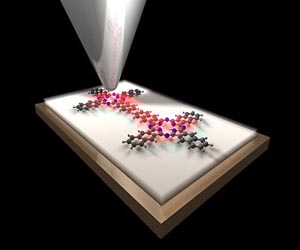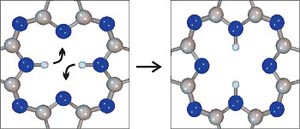Two back-to-back papers published by IBM scientists could herald the long-awaited advent of molecular or nanotech computing devices.
There has been much hyperbole written about the potential of nanoscience and supramolecular compounds that could one day be used as the building blocks of computer memory and other devices. But, at the end of August, computing pioneer IBM announced that it has passed the first two milestones in understanding atomic magnetism, bringing single-atom data storage closer to reality and in how to control single molecules as tiny switches. The exploratory research, published in the journal Science hints for the first time at a realistic strategy for developing nanotech computing with devices built from clusters of atoms or molecules.

Schematic tunnelling logical molecules (Courtesy of IBM)
In the first report from IBM’s Almaden laboratory, the scientists describe major progress in probing a property called magnetic anisotropy in individual atoms. This fundamental measurement has important technological consequences because it determines an atom’s ability to store information. Previously, nobody had been able to measure the magnetic anisotropy of a single atom.
This work suggests that it may be plausible to build structures consisting of small clusters of atoms, or even individual atoms, which could reliably store magnetic information or lead to entirely novel devices that go beyond conventional computing.

Single-Molecule Logic Switch (Courtesy of IBM)
In the second paper, IBM’s Zurich team describe the first single-molecule switch that operates flawlessly without disruption of the molecule’s overall structure. Moreover, the team demonstrated that they could switch atoms within one molecule using atoms in an adjacent molecule, which represents a rudimentary logic element, made possible only because the molecular framework is left undisturbed by the switching process.
IBM says both research threads represent a significant step towards building molecular-scale computing elements that are far smaller, faster and use less energy than any current semiconductor technology.
Further reading
Science, 2007, 317, 1199-1203;
http://dx.doi.org/10.1126/science.1146110
Science, 2007, 317, 1141;
http://dx.doi.org/10.1126/science.317.5842.1141a
Suggested searches
nanoscience
supramolecular